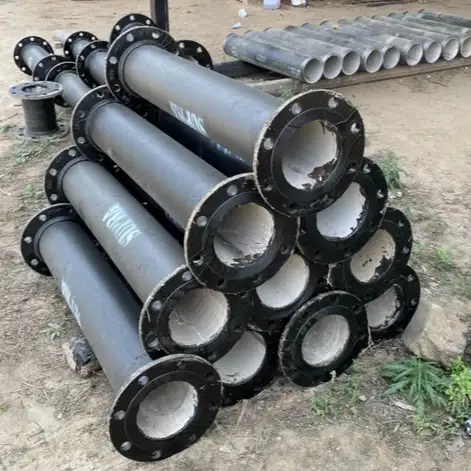Need accurate pricing for 2-inch ductile iron pipe? Current market rates range from 25 to 80 per linear foot, depending on specifications like AWWA pressure class (50/52/56), coating type (cement-lined vs. polyethylene), and order volume.

1. Overview of Ductile Iron Pipes
Ductile iron pipes are made from a special type of cast iron that has been treated to improve its strength and flexibility. They are commonly used in water and wastewater systems due to their ability to withstand high pressures and resist corrosion. The pipes are available in various diameters and pressure classes, which influence their cost.
2. Factors Influencing Ductile Iron Pipe Prices
Several factors contribute to the pricing of ductile iron pipes:
-
Diameter: Larger diameter pipes require more material and are generally more expensive.
-
Pressure Class: Higher pressure classes indicate stronger pipes, which cost more to manufacture.
-
Coatings and Linings: Protective coatings, such as cement mortar or epoxy, add to the cost but extend the pipe’s lifespan.
-
Joint Type: Push-on joints are typically less expensive than flanged or mechanical joints.
-
Manufacturing Location: Pipes manufactured in regions with higher labor and material costs will be more expensive.
3. Regional Price Variations
Ductile iron pipe prices can vary significantly based on geographic location due to differences in manufacturing costs, transportation expenses, and regional demand.
-
United States: Prices range from $25 to $60 per foot, depending on diameter and pressure class. For instance, a 6″ Class 350 ductile iron pipe may cost around $30.75 per foot.
-
China: Prices range from $425 to $720 per meter, influenced by local manufacturing capabilities and demand.
-
India: Prices range from $450 to $650 per meter, with variations based on local production and material costs.
4. Price Comparison with Other Pipe Materials
When considering ductile iron pipes, it’s essential to compare their costs with other materials like PVC and steel.
| Pipe Material | Cost per Meter | Durability | Applications |
|---|---|---|---|
| Ductile Iron | $425 – $720 | High | Water, Sewage |
| PVC | $100 – $200 | Moderate | Water |
| Steel | $300 – $500 | High | Industrial |
Ductile iron pipes offer a balance between cost and durability, making them suitable for long-term infrastructure projects.
5. Standard Pricing by Pipe Diameter and Class
The following table provides a general overview of ductile iron pipe prices based on diameter and pressure class:
| Diameter (inches) | Pressure Class | Price per Foot |
|---|---|---|
| 2 | 350 | $29.95 |
| 6 | 350 | $27.25 |
| 8 | 350 | $36.20 |
| 12 | 350 | $50.90 |
| 24 | 350 | $120.01 |
These prices are indicative and may vary based on supplier and location.
6. Additional Costs Associated with Ductile Iron Pipes
Beyond the base price of the pipes, several additional costs should be considered:
-
Transportation: Shipping fees can be significant, especially for large quantities.
-
Installation: Labor costs for trenching, laying, and joining the pipes.
-
Fittings and Accessories: Elbows, tees, valves, and other components add to the overall cost.
-
Maintenance: Regular inspections and repairs to ensure longevity.
7. Cost-Benefit Analysis
While ductile iron pipes may have a higher initial cost compared to materials like PVC, their durability and low maintenance requirements often result in lower total lifecycle costs. For instance, a study by McWane Ductile suggests that ductile iron pipes can offer significant savings over time due to reduced maintenance and replacement needs.
8. How to Obtain Accurate Pricing
To obtain accurate pricing for ductile iron pipes:
-
Contact Suppliers: Reach out to manufacturers or distributors for quotes.
-
Request Bulk Discounts: Larger orders may qualify for reduced prices.
-
Consider Local Suppliers: Purchasing locally can reduce transportation costs.
-
Compare Multiple Quotes: Obtain quotes from several suppliers to ensure competitive pricing.
9. Frequently Asked Questions (FAQs)
Q1: Why are ductile iron pipes more expensive than PVC?
A1: Ductile iron pipes are made from a stronger material and often come with protective coatings, which increase manufacturing costs. Additionally, their durability and longer lifespan can justify the higher initial investment.
Q2: Can I use ductile iron pipes for residential water systems?
A2: Yes, ductile iron pipes are suitable for residential water systems, especially in areas with high water pressure or corrosive soil conditions.
Q3: How do I determine the right diameter and pressure class for my project?
A3: The required diameter and pressure class depend on factors like expected water flow, system pressure, and local regulations. Consulting with an engineer can help determine the appropriate specifications.
Q4: Are there any alternatives to ductile iron pipes?
A4: Alternatives include PVC, steel, and HDPE pipes. Each material has its advantages and disadvantages, and the choice depends on the specific requirements of the project.
Q5: How long do ductile iron pipes last?
A5: With proper maintenance, ductile iron pipes can last 50 to 100 years, making them a cost-effective choice in the long term.
Q6: Do prices vary based on geographic location?
A6: Yes, prices can vary based on factors like local manufacturing costs, transportation expenses, and regional demand. It’s essential to obtain quotes from local suppliers to get accurate pricing.
10. Conclusion
Understanding the pricing of ductile iron pipes is essential for effective project planning and budgeting. By considering factors like diameter, pressure class, coatings, and regional variations, you can make informed decisions that balance cost and performance. Always consult with suppliers and engineers to ensure the chosen materials meet the specific needs of your project.
